Modern warfare runs on information. Forces in the field produce increasing amounts of data, and rely on data from other sources to find and engage the enemy. Bandwidth is the second most precious commodity on the modern battlefield, behind only time. And the vast majority of that bandwidth is supplied by satellites.1

The first communications satellite
The initial impetus for military satellite communications came out of the problems of the nuclear age. High-frequency radio had long been the best way to send messages to mobile recipients over long distances, but it relied on bouncing off the fickle ionosphere. This was unacceptable when the credibility of the US deterrent rested on the ability to reliably order forward-deployed bombers2 and carriers to attack. The obvious solution to all of this was to replace the ionosphere with a more reliable reflector, and a number of options were investigated, including the Moon (a spinoff of plans to use the Moon for SIGINT), the ionization trails left by meteors, a giant orbital balloon and a reflective layer of orbital needles. Of these, only the meteor trail method ever saw wide operational use,3 although bandwidth is limited and the most prominent user today is the SNOTEL system for reporting snow depth in remote areas.
Instead, the winning solution was the active communication satellite, which could receive a signal from the ground and then amplify and transmit it to a distant recipient. This would require using frequencies which didn't bounce off the ionosphere, but it turned out that these frequencies ran from VHF (30 MHz) up, which meant smaller antennas and more bandwidth in the resulting signal. The sweet spot was in the UHF band, 225-400 MHz. The frequency involved was high enough that the antennas could be reasonably sized, but low enough that it wasn't too badly affected by weather, and the electronics were cheap (a major consideration during the Cold War). The fact that beams were reasonably wide was a major advantage to mobile users. They didn't have to worry about pointing their dishes all that precisely, and neither did the satellite.
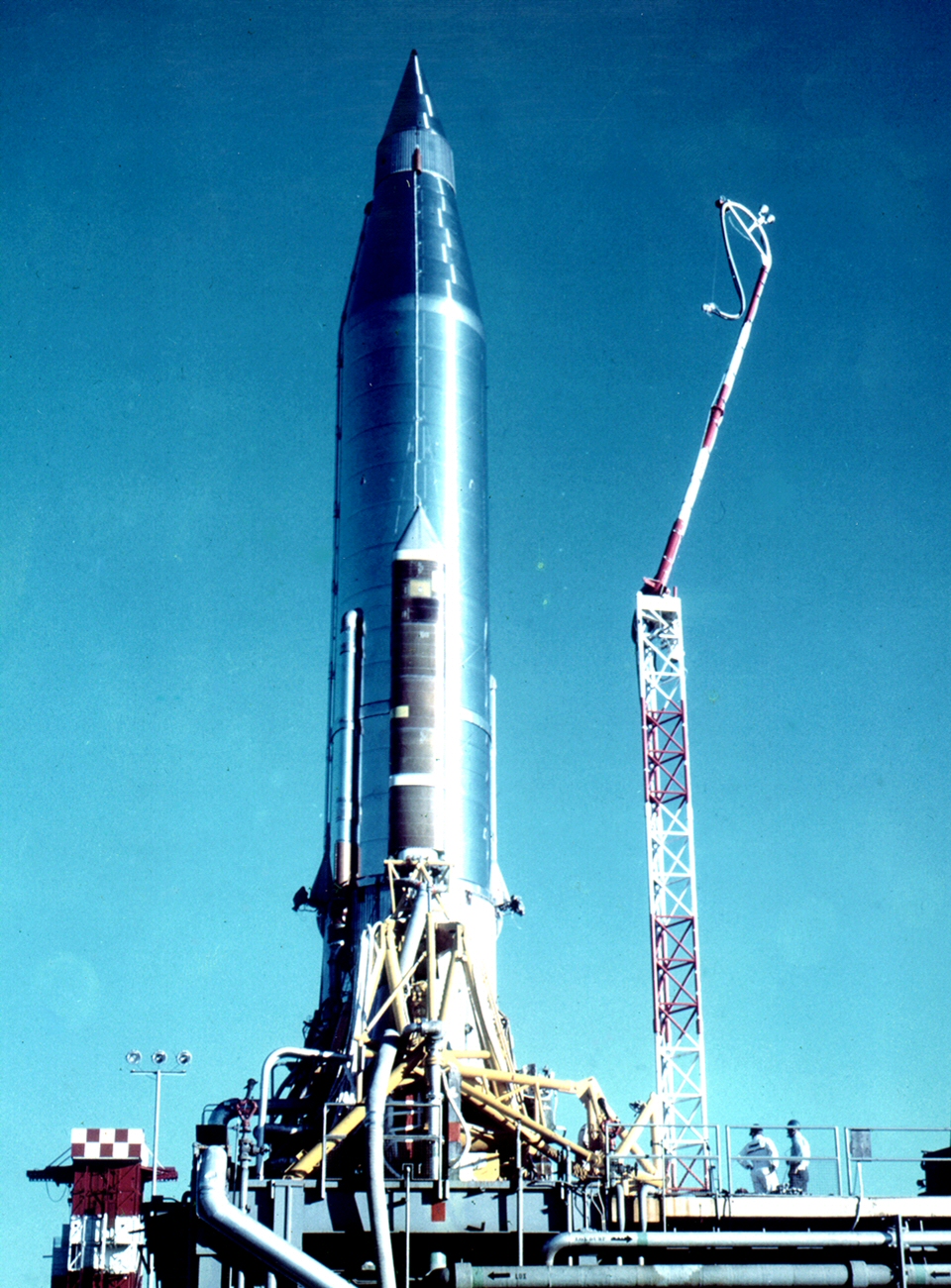
The Atlas missile carrying SCORE
From an operational point of view, all of this is made much easier if the satellite is in geostationary orbit. The operator sees the satellite in a fixed position in the sky, which means that even a moving platform needs only a simple tracking mechanism, and a stationary user can have a fixed dish. While this was recognized even before the space age,4 early boosters were too anemic to lift a useful payload to GEO. The alternative chosen was known as "store and forward", where a satellite in LEO with an onboard recorder would receive a message when in view of the transmitter, then pass it to the recipient later on. This was first tested on a mission known as SCORE, which broadcast a Christmas greeting from President Eisenhower in 1958, as well as carrying messages between ground stations. It was soon followed by Courier, which combined store-and-forward capability with the ability to serve as a real-time relay if the satellite was in view of both ground stations.

A model of Telstar 1
In July 1962, the US launched Telstar 1, the first operational communications satellite, which among other things passed the first live television signals across the Atlantic. A 30-minute window was available on each 2.5-hour orbit, and getting a useful signal from the 14W transmitter and omnidirectional antenna on the satellite required a 340-ton steerable horn antenna. The only problem was the satellite's failure after 7 months, largely due to the side-effects of the Starfish Prime high-altitude nuclear test.
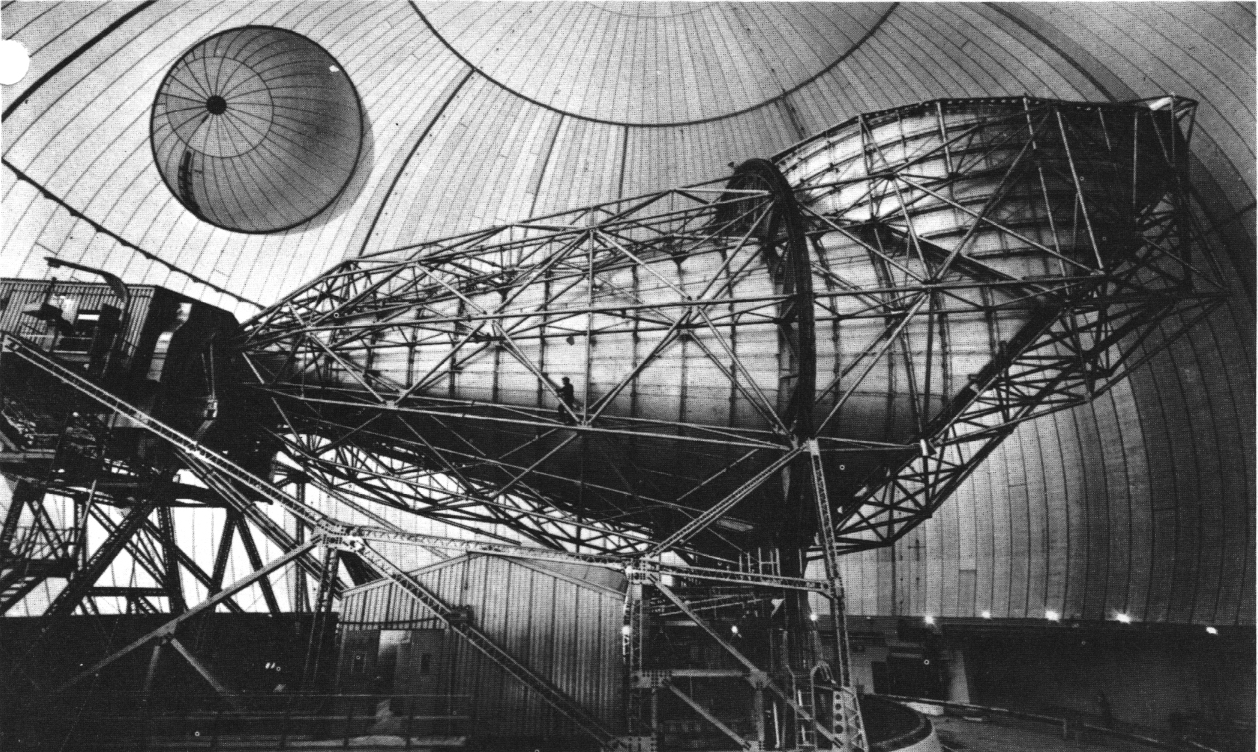
The huge steerable horn antenna
A year after Telstar 1's launch, it was followed into orbit by Syncom 2, the world's first geosynchronous satellite, although its 28° inclination meant that it did move back and forth across the sky somewhat. Booster limitations meant it weighed only 35 kg, half of what Telstar did, and the transmitter had only 2W of power and enough bandwidth for a single phone call. Tests were conducted between land stations, ships and aircraft, and the follow-on Syncom 3, positioned directly over the equator, had an improved transponder that could support a television signal,5 relaying footage of the opening of the 1964 Olympics from Japan to the US.
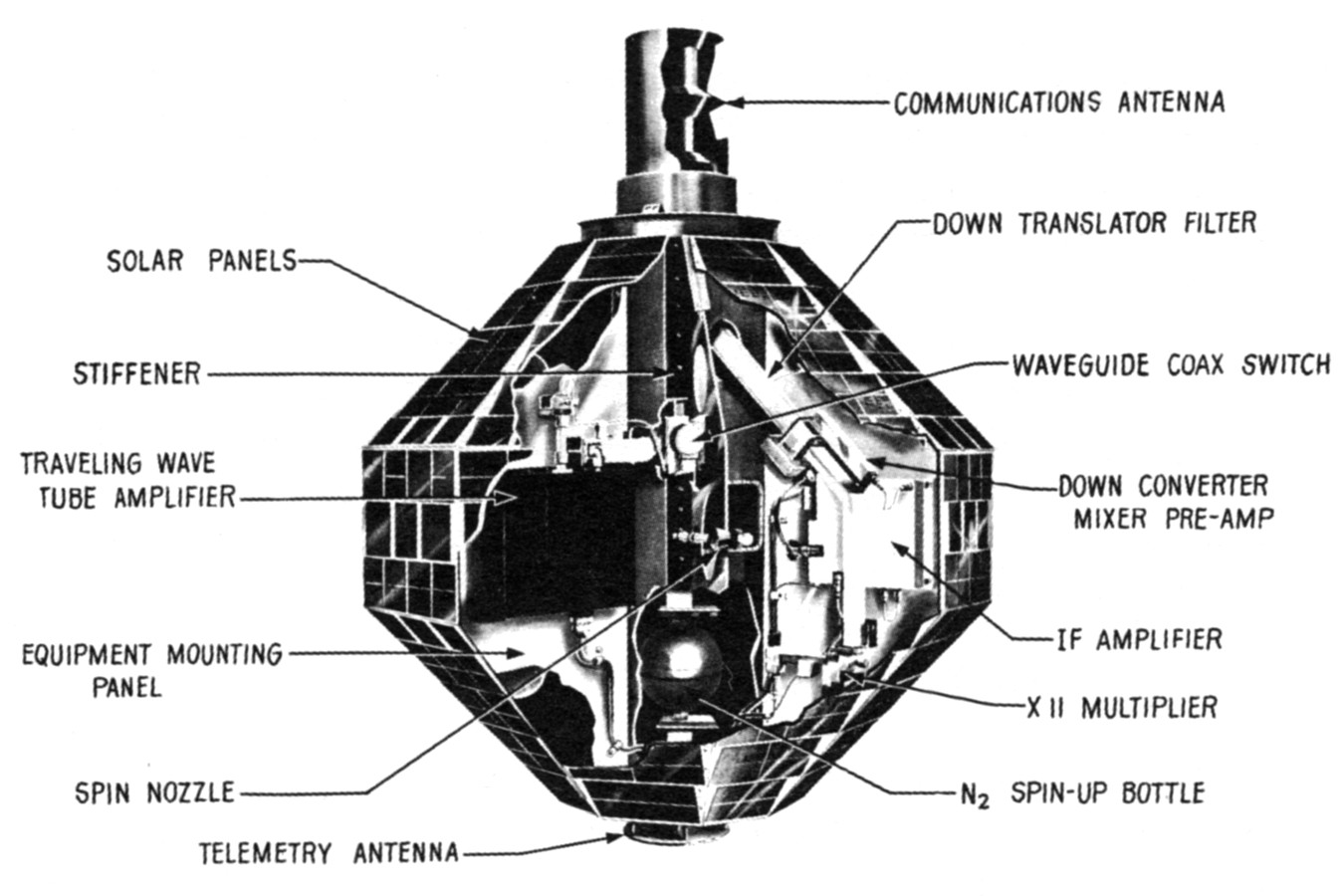
A DSCS I satellite
This was proof of concept enough for the DOD, and work began on the Defense Satellite Communications System, which initially was to be a constellation of a dozen or so near-synchronous satellites6 working in the SHF band, primarily to provide high-bandwidth communications between senior leaders, either aboard flagships or at fixed sites ashore. These arrived just in time to allow leadership in DC to micromanage the Vietnam War to an unprecedented degree, for instance by making it possible to send high-quality photographs back in near-real-time so that Johnson and McNamara could decide if they needed to be bombed again. This7 worked well enough that it was soon followed by the more sophisticated DSCS II, which was a truly synchronous system with multiple separate transponders to provide different users with specific channels that provided the US military with strategic communications through the 70s and 80s, allowing up to 1300 simultaneous voice channels.
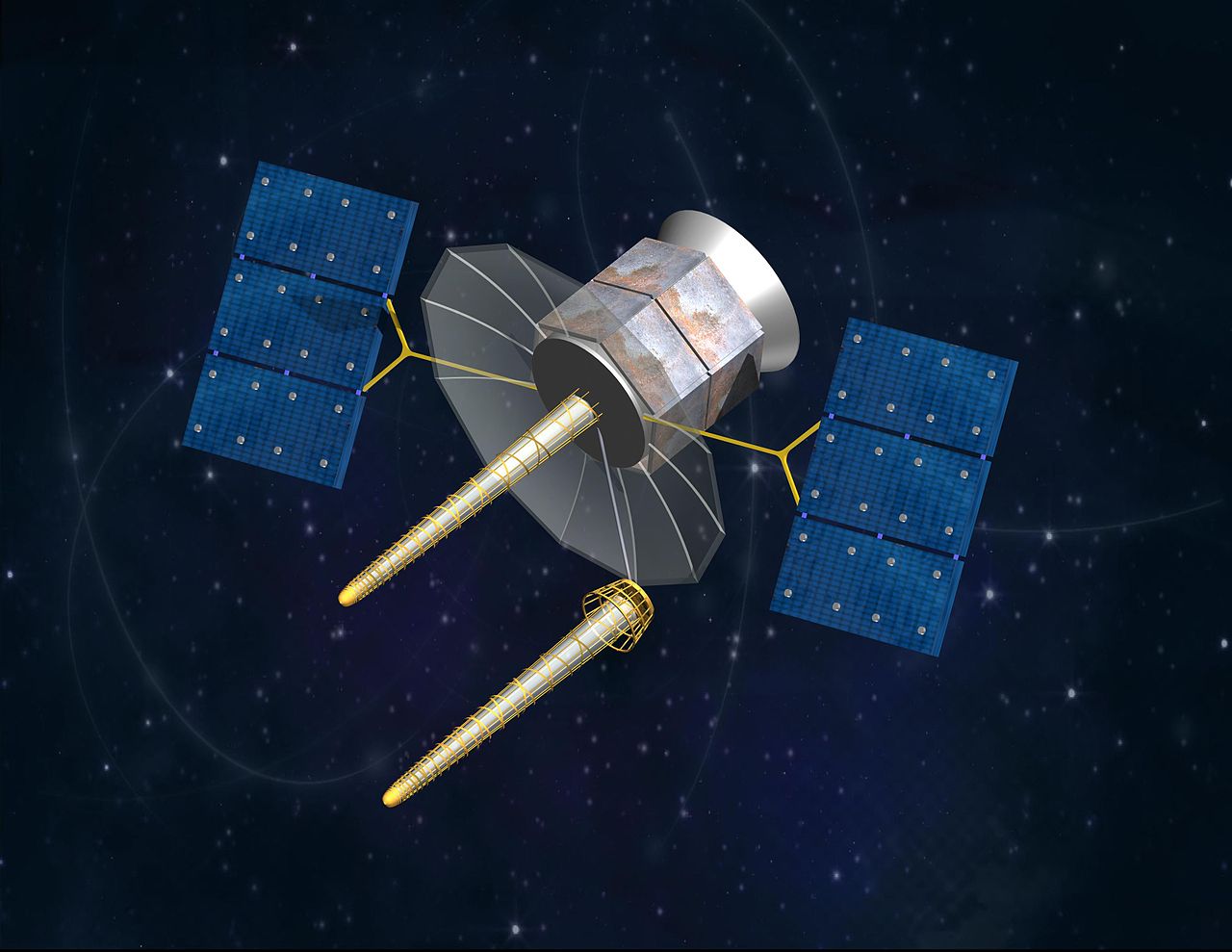
FLTSATCOM, the first major UHF satellite constellation
But all of these were intended primarily for use by only the highest levels of leadership. Electronics in the relevant frequencies were expensive and not very efficient, which meant limited ground stations and large dishes. For true tactical use, particularly aircraft and mobile ground users, a lower frequency would be required, probably in the UHF range. This band was already in use for tactical purposes, and it allowed a reasonable amount of power to coexist with a practically small antenna and good weather resistance. The first tests of this took place in the late 60s, when the US launched TACOMSAT, and they proved quite successful with both aircraft and ships. The Navy quickly produced a broader UHF system, first leasing transponders on commercial satellites and then building a dedicated constellation. The highest-priority use of this system was for a new fleet broadcast, which passed information from higher headquarters to the entire fleet, saving a great deal of message traffic and letting even quite low-level units access the flood of information produced by US intelligence sources. The submarine force was another enthusiastic user of the new system, as the high data rate of UHF meant that submarines could get updates with only a short mast exposure, and they could pass back data with minimal fear of interception.
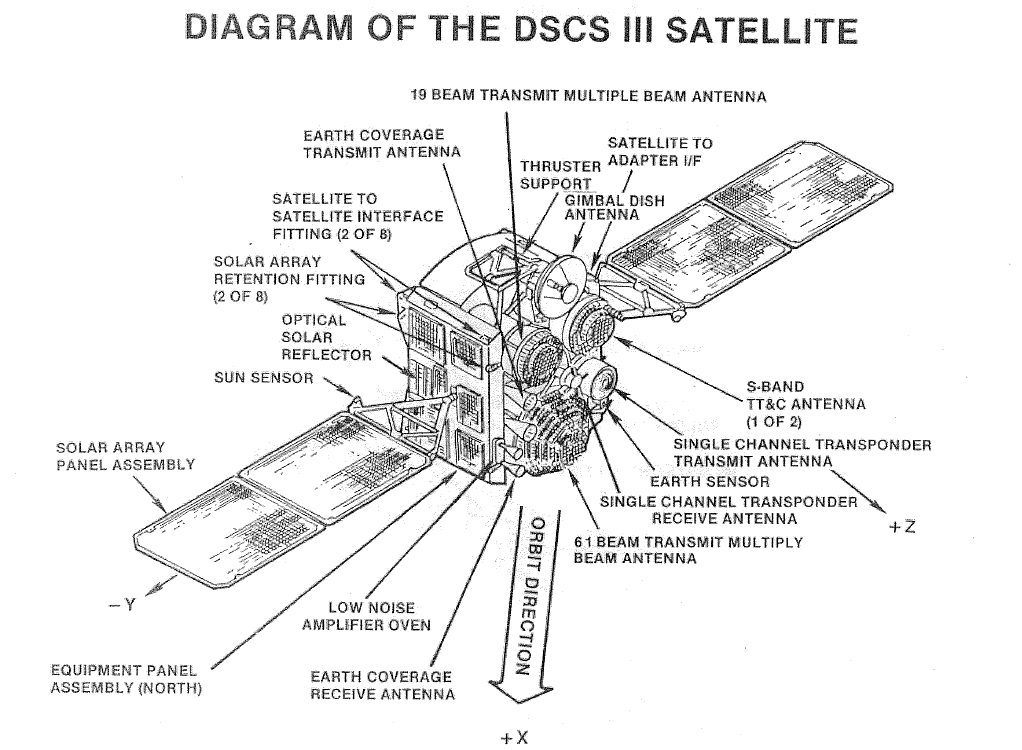
But all of these systems had a major problem: they were essentially designed for use in a permissive environment, and tended to simply send back whatever signals they received. This was annoying when Brazilian loggers found out that they could hijack the USN's satellites, but in a full-scale war, the enemy could easily saturate the transponders and drown them out. There were also concerns about nuclear hardening and resistance to anti-satellite weapons. DSCS III was the first system to take this problem seriously, using steerable antennas which could be pointed away from jamming sources and multiple transponders which could be set up for the needs of different users. It was followed by Milstar, an EHF8 satellite designed for nuclear command and control, which inspired a truly impressive degree of paranoia. EHF beams are quite narrow, reducing susceptibility to jamming, and the satellite is equipped with steerable nulls which could allow it to completely ignoring jamming quite close to the recipients. To reduce the need for ground stations, the satellites can communicate with each other using a band that was chosen because it was absorbed by the atmosphere, and there was far more automation in message prioritization and routing that was typical for comsats. All of this meant abandoning the "bent pipe" method of routing messages. Instead, the messages were entirely digital, with the satellite processing them as a series of bits, which also gave far better resistance to noise.
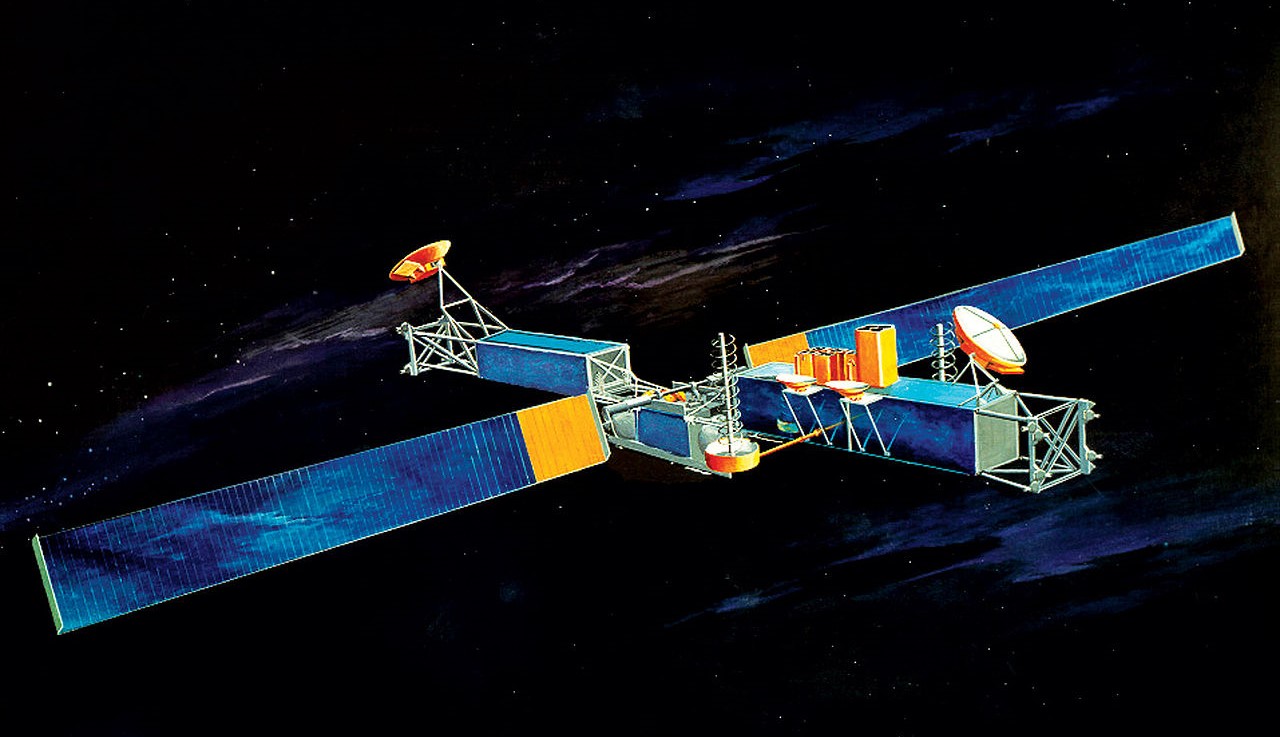
Milstar
The switch to digital messages also solved another problem, which hadn't been apparent until Milstar was well underway. The USN had treated satellite communications as a solution to the problems of over-the-horizon communication without the risk of enemy direction finding, something that became increasingly important as fleets dispersed, first due to nuclear weapons and then as deceptive formations were adopted to hide from RORSATs. The uplink beam was pretty narrow, while the wide downlink in theory gave no indication of the location of the sender. In practice, they discovered that there was enough doppler shift between the sender and the satellite to give some indication of where the sender was, a shift that was preserved in the downlink. Handling the messages digitally removed this doppler, and it has since become standard on comsats.
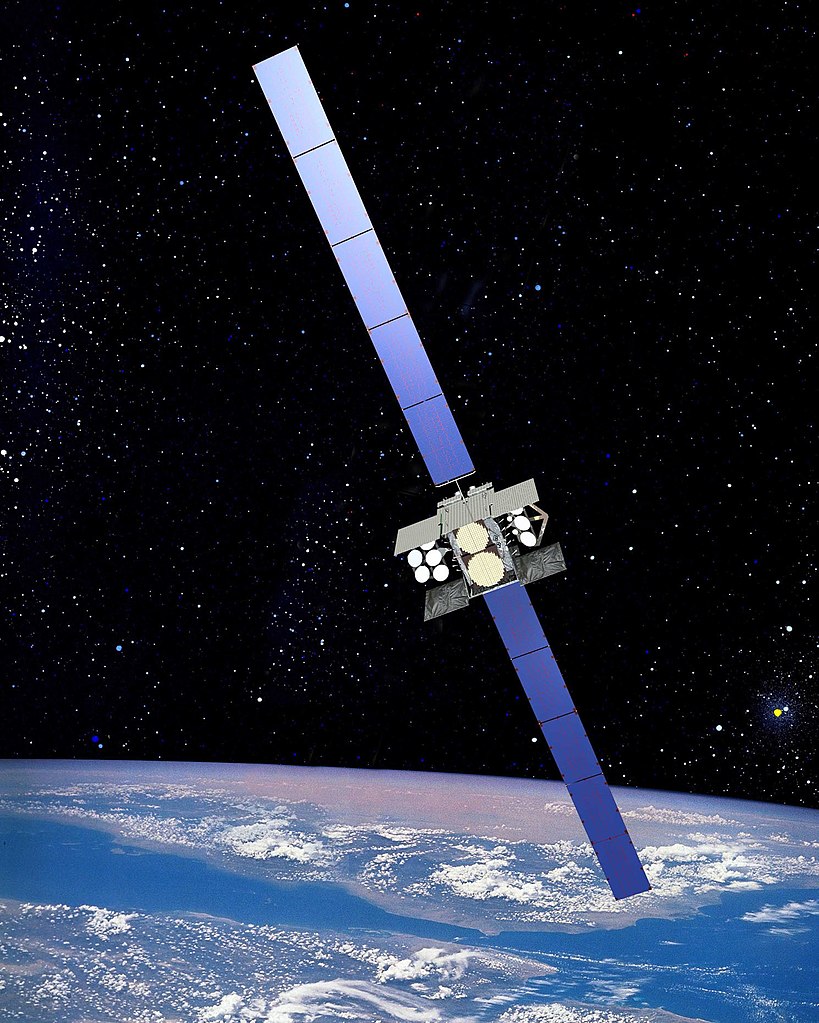
Wideband Global SATCOM
The years since the end of the Cold War have seen satellite communications massively grow in importance, thanks to increasing dependence on remote sources of data. For instance, in the late 80s, a carrier group was expected to need about 144 kbits of data per hour, primarily in the form of text. By 2000, this had reached 6 Mbits every second for the carrier itself, growth driven by increasing use of raw data onboard the ship, and particularly the need to support Tomahawk targeting. Supporting this data load required merging satellite channels that had previously been dedicated to specific tasks on the software level, although the US continued to maintain three separate types of comsats thanks to the different hardware and capabilities of the systems. Milstar's survivability made it very expensive, and the program was dramatically scaled down after the fall of the Soviet Union, with the cheaper AEHF satellites replacing them in the nuclear command/survivable system role. DSCS III was replaced by Wideband Global Satcom, while the UHF Fleet Satellite constellation was replaced by the UHF Follow-On (UFO) and more recently MUOS, which is based on the architecture of the cell phone system. There was also the introduction of the Global Broadcast Service, a high-volume one-way channel that allows tactical users unprecedented access to intelligence data, much of which is derived from the space assets discussed in previous parts.
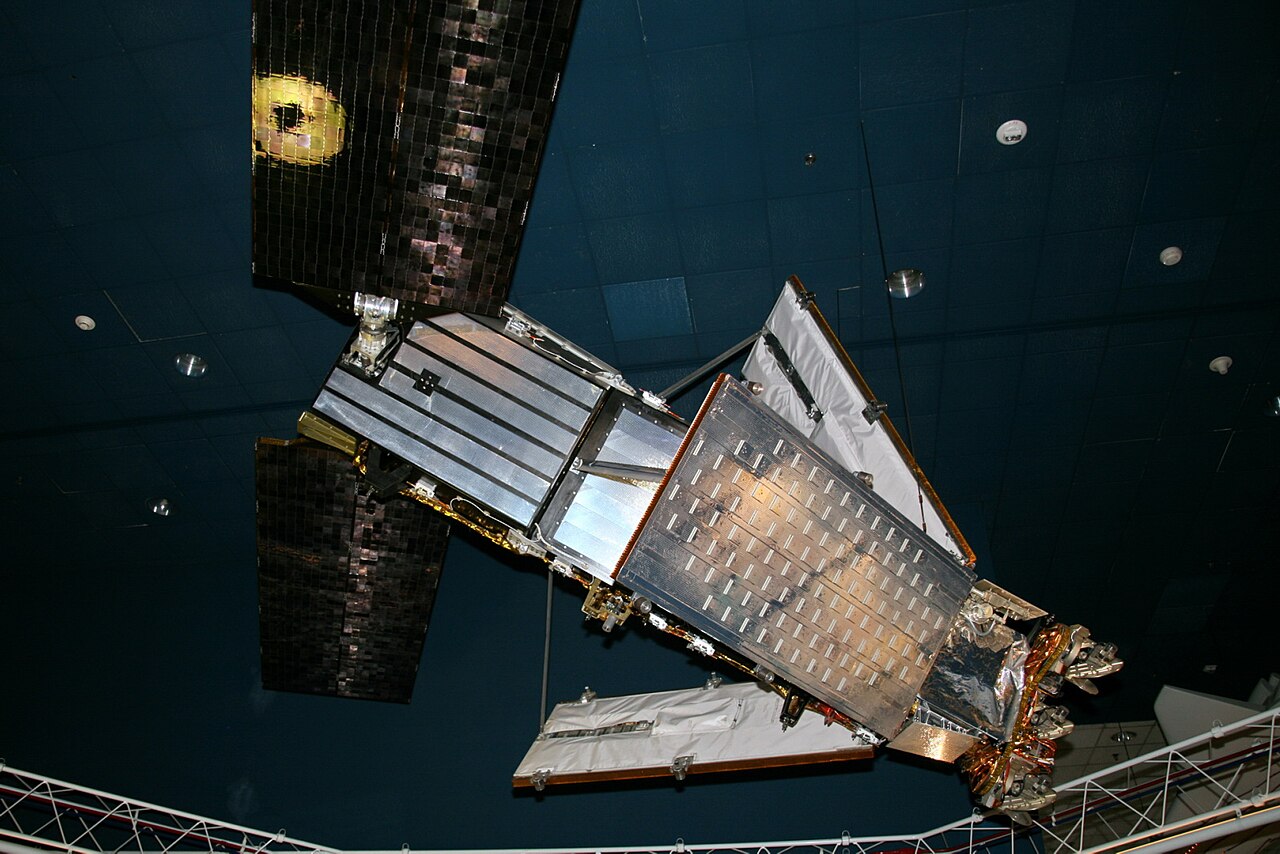
An Iridium satellite
Even this array of systems is still insufficient to keep up with the demands of the US and its allies, many of whom also rely on US Satcom systems. As a result, the DoD is also one of the biggest users of commercial Satcom services, initially the geostationary Inmarsat constellation, which provided long-range communications for many poorer navies as well as merchant ships and major navies needing emergency long-range communications. In the 90s, Inmarsat provided the USN with its first fleet-wide high-speed network, allowing use of email and other features that seem rather quaint today, but gave greatly improved connectivity. Later, they also became major users of the Iridium and Globalstar constellations, which were the first systems since the very early days to operate in LEO. These were designed to provide satellite phone services, and the low altitude allowed them to communicate with cheap, omnidirectional handsets. Iridium also made use of intra-satellite relay links, similar to Milstar, while Globalstar requires the satellite to be within range of a ground station to function. Unfortunately, the rollout of terrestrial cell phones was more rapid than the developers of these systems anticipated, and the DoD ended up as the biggest customer for the post-bankruptcy constellations in their insatiable quest for more bandwidth.
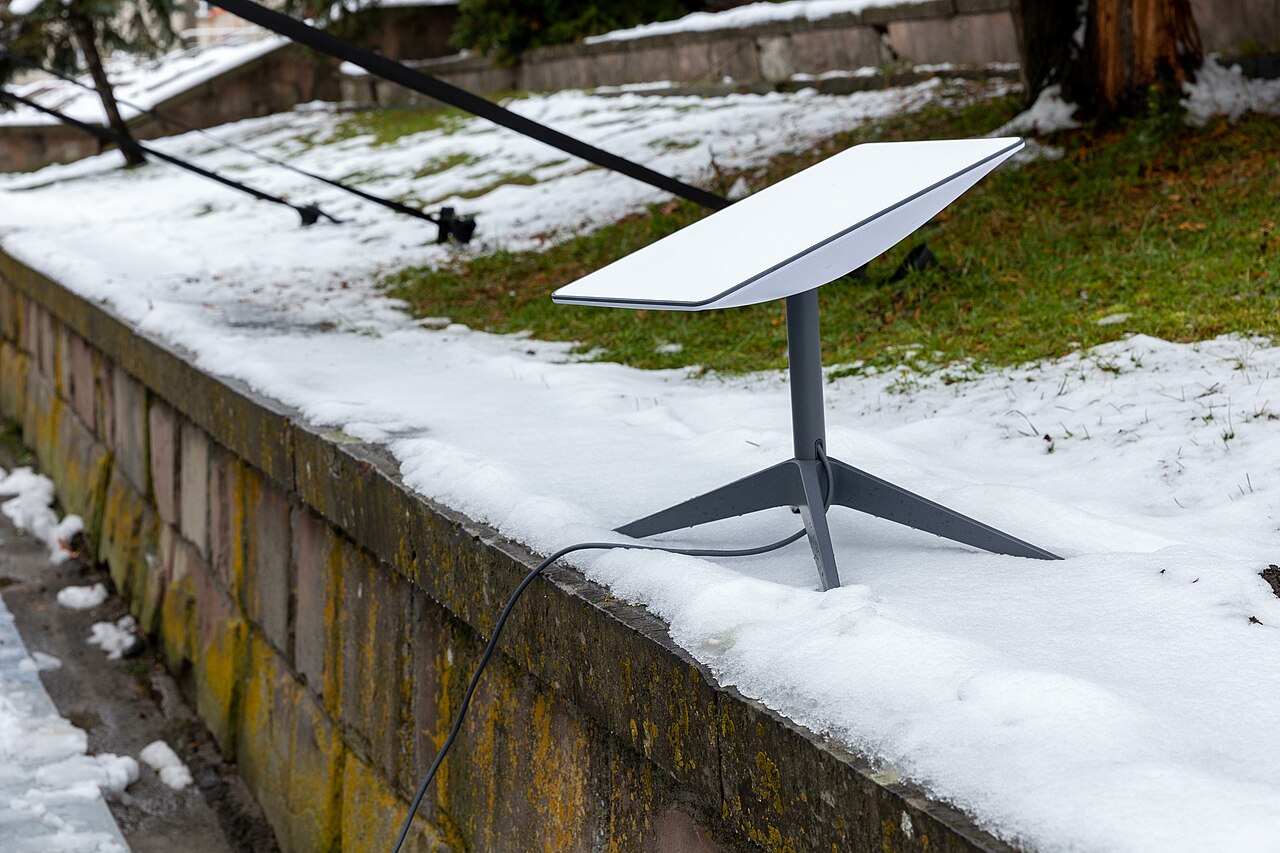
A Starlink antenna in Ukraine
Today, we are seeing the LEO comsat revolution completed in the form of Starlink and its various competitors, which are offering high-speed satellite internet through massive constellations of LEO satellites, which have shown their capability recently by allowing the Ukrainians to enjoy the flexibility provided by satellite communications in the field with a tiny fraction of the DoD's investment. The Starlink system is a particularly interesting as a contrast with the early days of satellite communications. It works at the SHF and EHF bands, and in contrast to the earlier LEO constellations, it relies not on an omnidirectional antenna, but on a small phased array, which can track the satellite as it goes past entirely automatically. This makes it extremely hard to intercept, and allows more efficient use of bandwidth. Starlink also makes extensive use of links between satellites, reducing reliance on ground stations. The net result is that not only can Ukrainian commanders coordinate on the move, but Ukrainian soldiers can access the internet even on the front line. The DoD is obviously interested in the technology, and has both bought bandwidth from Starlink and looks to be building a similar constellation of its own, which in a stunning display of five-sided thought mixed with business buzzwords, they are calling the "transport layer" of the National Defense Space Architecture.
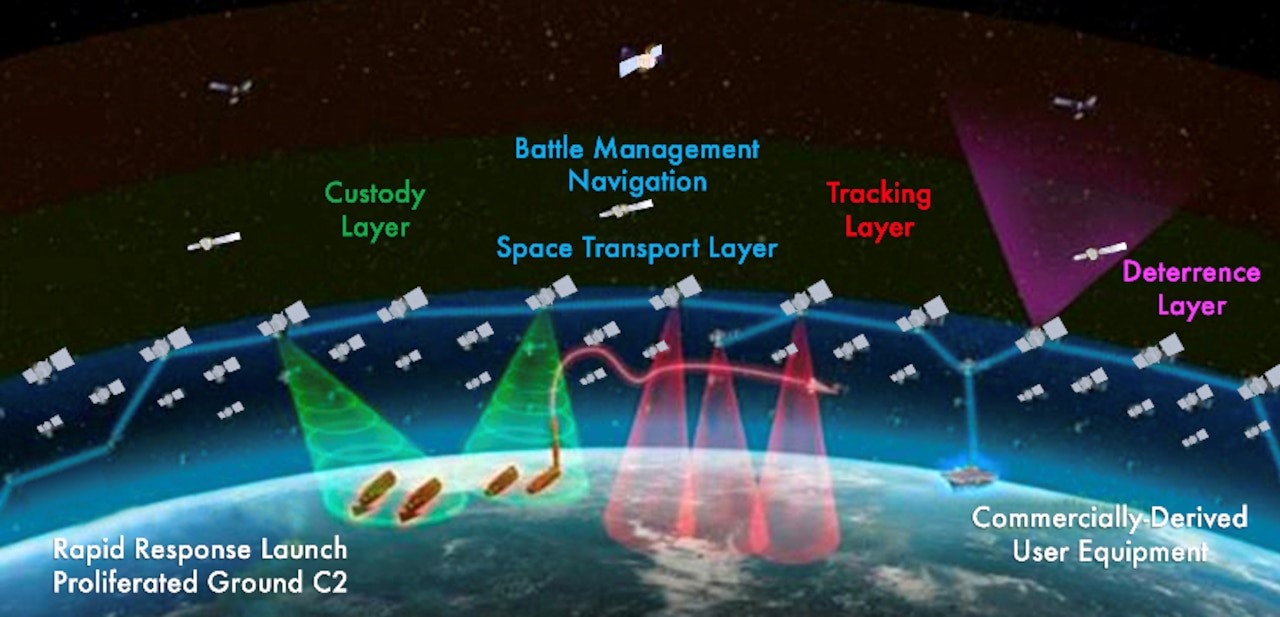
Warning: Excessive Buzzwords. Look away if you feel faint.
Today, satellite data is more common and more plentiful than ever, but even as the ways of passing information around have multiplied, so have the uses for it. With even small units now taking part in networks, it appears that the LEO constellations have arrived just in time, and even they will probably soon be overwhelmed by the demands of forces in the field, which are able to take advantage of information both from and passed by satellites, combined with positioning data, to maneuver in ways never before possible. We'll take a look at the last category of direct satellite services next time.
1 I've written about satellite communications before in a specifically naval context, and there's more overlap than usual between that post and this one. I didn't think that could stand as a full overview, and figured it was better to repeat some material. ⇑
2 Note that while bombers could be launched on warning of a Soviet attack, they were under orders to hold at so-called fail-safe points and await the "go-code" before attacking. This was kept secret to keep the Soviets from trying to decapitate the command infrastructure. ⇑
3 Moon relay was fitted to a few ships, most prominently the surveillance ship Liberty, and the Moon relay dish was one of the first knocked out during the Israeli attack. ⇑
4 Science fiction author Arthur C. Clarke famously proposed the idea in 1945, although he expected it would need a crew to change burned-out vacuum tubes. ⇑
5 I should probably point out here that figuring out how much data can be passed through a given link is really complicated, and depends on power, signal bandwidth (not the same thing as data bandwidth) and the antenna on each end, and is made more complicated in the satellite case because the transponder will generally amplify any noise the receiving antenna picks up. The signal bandwidth (how far from its central frequency your signal can vary) sets a hard upper limit, but within that, the available data bandwidth is set by the coding system, which in turn is usually driven by available signal-to-noise ratio (SNR). To simplify, a system with a low SNR might only be able to tell the difference between "on" and "off", while a link with a higher SNR might be able to tell apart 16 different levels. So for each time interval, the second link can pass 4 times as much information (2^4 = 16). The TV relay probably involved really big antennas at both earth stations, while the same satellite might only be able to provide enough data for a teletype if talking to an airplane in flight. ⇑
6 Clusters of the DSCS I satellites were launched together on a single booster, and to make both deployments and the satellites themselves simpler, and to provide redundancy in the event of failure, they were placed in an orbit slightly below synchronous altitude, where they would drift about 30° east each day. The antennas still had to track the satellites, but they could do so relatively slowly. ⇑
7 The DSCS system, not idiots in Washington picking targets. ⇑
8 Extremely high frequency, the band above SHF. ⇑

Comments
These arrived just in time to allow leadership in DC to micromanage the Vietnam War to an unprecedented degree, for instance by making it possible to send high-quality photographs back in near-real-time so that Johnson and McNamara could decide if they needed to be bombed again.
Just who is they "they" in this statement? Are Johnson and McNamara going to bomb themselves, again?
I wish. "They" in that sentence refers to the targets.
It's interesting to see where commercial technology is really lowering the barrier to entry for nation-state level technologies (low/mid-tier drones, and moderate/high resolution optical surveillance satellite data as well), and where it isn't.
Combine these two and Starlink has a very small civilian market, also don't buy shares unless they're priced well below market price and can be sold immediately after purchase.
@RedRover
Yeah, my usual take on this stuff is "the US military has been able to do that for ages", which is true, but probably underrates how much things are changing for everyone else.
@Anonymous
I'm not sure that's the conclusion I would draw. The bet that the satphone companies made in the early 90s was that they would be the only ones able to offer good coverage in a timely manner. They were wrong about that. That's not what Starlink is selling. Broadband isn't new technology, and we've had enough trouble getting it reliably to everyone that Musk apparently sees an opening. I emphasize the mobile aspect here because that's what's more relevant to the military, but I believe you have to pay extra for that, which is very much not the case for things like satphones.
@ Anonymous (about Starlink market issues) The market for satcom is very different now than it was. Starlink is competitive in both bandwidth and latency against landline broadband data, much less analog cellular voice. Shannon is weeping tears of joy.
Nitpick: 8
Actually, I think we're both wrong. The two-position link is obviously sending 1 bit. The 16-position link is sending the equivalent of 4. (Does it show that I don't have a background in this stuff?)
nitnit: 4x more information (16 levels allows 4 bits per 'character', 2 levels gives 1 bit)
@RedRover I think Starlink is cool in that it has a function in providing internet access for 2nd and 3rd world countries but they as a mess for astronomers. I dislike them for all the visual clutter they create.
Bean, I suggest that the "transport layer" of the National Defence Space Architecture may be a sign of good design practice rather than buzzword bingo. (Qualified "may" because I don't know the full details.)
From time to time I've been a TCP/IP network admin and developer of realtime networked programs. 14 years ago I also took a short course on military tactical data links. What struck me about Link-11 and Link-16 was how they specified everything top to bottom, from radio frequencies to precise packet formats. This is how civilian computer networks such as IBM SNA and DECnet were designed in the past. It gets you a network that does one thing very well, but is difficult to adapt and expand.
The Internet is designed differently, and if the NSDA people are smart they're doing the same. The transport layer (UDP, TCP, QUIC for Internet) is where applications meet the network. The transport layer doesn't need to know what "the data" is, just what service is required. Want low latency and don't need reliability, do this. Need every bit exactly as sent, do that instead. If it's encrypted, use this, this, or this algorithm, indicated by that header. And so on.
Done properly it should result in a network that can handle the unknown future requirements without having to tear everything down and reinstall.
Hugh, all good points, but one problem: they've been doing "it's just data, get it there somehow, we don't care" since the late 80s. That's what I was getting at when I mentioned "merging satellite channels", although I wasn't terribly explicit because there was a lot of ground to cover. For Link 16 specifically, there's JREAP-B, which is L16 messages over IP, and VMF (the datalink after L16, mostly used by ground forces) is independent of the system used to move the messages around. With that background, I'm not sure why you'd call it the "transport layer" unless you're trying to sound all cool and computery, given that "communications constellation" is clearer. And won't get bloggers taking potshots at you.
bean:
Countries that aren't the US don't seem to have been having so much trouble and even if you can't run fiber everywhere Musk is still betting that 5G won't be deployed widely enough to compete with Starlink in non-remote areas.
Ian Argent:
But is it different in a way that won't result in Starlink copying Iridium?
Ian Argent:
Yes, but if you have access to a fast landline (fiber or HFC) that'll probably be cheaper, even if you don't 5G being closer can use less power and smaller antennas (which is mainly of concern for mobile devices).
It's possible that the main function of Starlink won't be to connect the US to the internet, but to force those who own fiber, coax or 5G base stations to improve their offerings.
bean:
Sounds even more buzzwordy. Transport layer is at least technical jargon.
Interesting. I suppose this depends on where you come from. To me, "communications constellation" is straightforward and non-buzzwordy, given that one word is the obvious one to use for what they're doing, and the other is the standard term for "a collection of satellites". "Transport layer" may be technical jargon, but it's for the wrong field, which makes me suspect someone is ODing on buzzwords.
bean, I'm sure that the more far sighted mil network people have been trying for "get it there somehow" for a while, but there's still a long way to go. The best counter example is of course the F-35. Here's a story from 2021 (!) about how the USAF F-22s and F-35s cannot send tactical data to each other directly, but must bounce through a U-2 acting as a protocol converter.
https://www.popularmechanics.com/military/weapons/a36320168/f-22-and-f-35-fighter-jets-communicate-with-u2-spy-plane/
I don't understand why the USAF puts up with this. In the 20th C, maybe. 21st C, WTF? To me, it's like being told that I can't send email to someone because I'm using Outlook WiFi and they're on Outlook mobile phone.
The U-2 itself is I think using the USAF "Freedom 550", an attempt to build a standard datalink that uses IP for everything and can be installed in many different USAF aircraft. This project was started in ... 2015. Oh well, better late than never.
I don't think failure to adopt "everything is just IP" is a sign of incompetence. Military comms have requirements that just don't show up in the civilian sector, and include things like resistance to jamming and not being picked up by the enemy. There are times to abstract all problems and throw it onto the mercy of the network gods, and times to be really careful and close to the metal, and the military has more of the later than the civilian world. Re the F-22/F-35 communications, keep in mind that both are using specialized stealthy (directional) links intended primarily for intraflight comms. It's somewhat weird that they changed the standard between the two, but presumably the F-35's system brought enough capability to be worth it, and the F-22 was supposed to get it before the program was cancelled in 2010.
A lot of this is that we have/had a standard link, Link 16, but it's not stealthy, so we now have to figure out how to handle stealthy datalinks and how to have them talk to the large base of legacy Link 16 installations. In that environment, adding the IFDL capability instead of upgrading the F-22s makes a lot of sense.
I don't think failure to adopt IP is incompetence either, but not doing so is the opposite of “it’s just data, get it there somehow, we don’t care”. If that's what you want, IP is the answer.
IP runs over electrical power cables, acoustic phone lines, coax, twisted pair, fibre optic, UHF, S-band, C-band, Ku-band, lasers, and LED lightbulbs; so I'm skeptical about any claim "our network is a special snowflake, we can't use IP". (If anyone wants to argue that you can't use TCP on a stealth link, I'll agree! That's why we design networks in layers. TCP is not IP.)
If the air superiority jet can't exchange tactical data with the strike/SEAD jet, OK, I'm not the USAF, maybe they're happy with it.
Getting back to the original article, this is why I think "transport layer" appears in the diagram. It's there to assure everyone else that this won't be another F-35 MADL, that there won't be thirty odd years between "it's just data" and actually starting work on a common datalink.
There are lots of cases where "it's just data, get it there" is the right answer, and the military uses IP in those cases. See JREAP-C (not B, misremembered there) for an example. There are reasons that LOS L16 didn't do that, even leaving aside that I don't think IP existed back then. The big one being that the L16 network inherently figures out the relative position of participants using time delays, solving something that was a really major problem before GPS showed up and made it trivial.
It's less that they're happy with it than that they're dealing with a hard set of problems. I suspect that the switch from the F-22 to the F-35 had to do with the need to support the F-35's sensor fusion between flight members, which the F-22 didn't really do. I don't know details on those links, but it seems very plausible that there were sound technical reasons to abandon the F-22 link's radio format, particularly if they planned to upgrade. If they need to talk, I guess they do it through a gateway, which we're going to need anyway because a lot of the installed base is Link 16. Nor are gateways new. There are specific carveouts in the L16 spec for information relayed from a gateway to Link 11, and the British had a few ships fitted as gateways between Link 11 and their standard Link 10. To put it another way, even if we're both using IP, we can't talk if all you have is an acoustic modem and all I have is a fiber port. Someone has to sit between us anyway.
Re. the passive radio reflection balloon, I genuinely had never made the connection that inflating a balloon in space takes approximately 0 atmospheres of pressure.
Just one of those obvious-in-retrospect "oh right: space" moments.
The term transport layer is probably a reference to the 7-layer OSI model for networking.
When dealing with stealthy data links, the issue is probably not one of IP not working. The issue instead is going to be one of physical or data link layer (layer 1&2 of the OSI model) changing. IP will run over almost anything. Ethernet will run over a fairly broad subset of "everything" as well. Fiber optic, twisted-pair cable, and wireless "wi-fi" are the obvious examples.
It wouldn't surprise me to find out that a different physical layer for ethernet would won't work. I wouldn't rule it out, but I can see different needs here.
IP rides on top of this. Maybe there are better options which have been developed for military applications. At the same time, IP handles most things mediocrely. It isn't great at much of anything, but it is highly extensible and well-understood. It'd be like having military trucks use non-standard custom-sized bolts for everything. The advantages are that you might save a pound of weight across all the bolts in the whole vehicle, and that everybody hates the bolts, rather than having one part of NATO being able to buy off-the-shelf wrenches. But you lose out so much on being able to buy replacement parts and replacement tooling off-the-shelf that it isn't worthwhile.
Writing a custom network or transport layer protocol (layer 3/4) strikes me as crazy as doing custom-sized bolts. Maybe it's worthwhile but it's expensive. And if you'd better be able to back up your decisions with a lot of analysis or math.
Doing a custom layer 1/2 solution strikes me as probably reasonable and likely necessary, though.
@bean
This is very true. I think even Google Earth is quite transformative - free aerial photographs for anyone with a cell phone that would have been multiple hundreds of millions of dollars to obtain as recently as the late '80s. Obviously they're not real time, but nonetheless it makes reconnaissance and mapping vastly easier. (Doubly so now that people can buy 0.5m-1m resolution commercial satellite imagery)
Its been a ~year; so what's next?
I suggest Hybrid Satcom, reference https://afresearchlab.com/technology/global-lightning/, where large, advanced, phased array antennas pointing in different directions can be used to connect to many different space and (why not also?) line-of-sight systems, sometimes simultaneously, which not only enables one to communicate with more variety but also to act as gateways for older, nearby nodes.